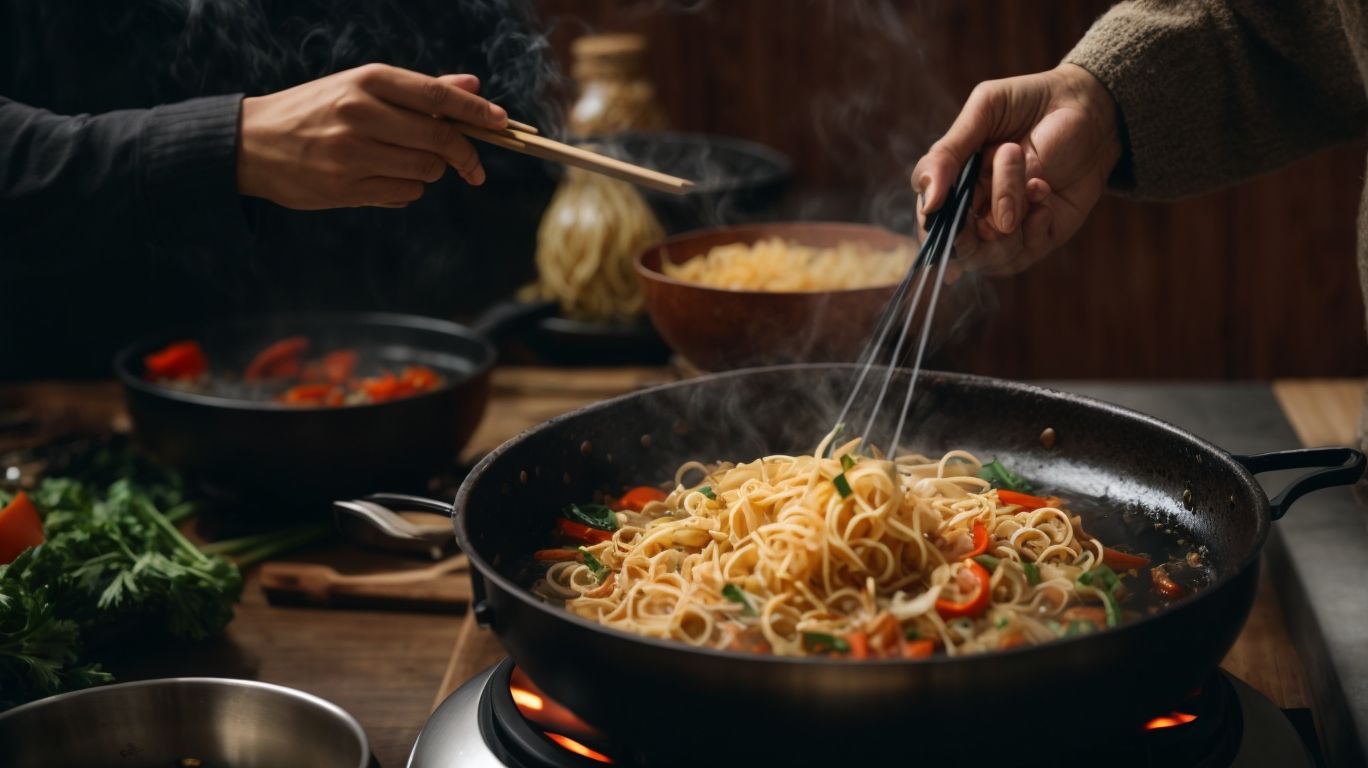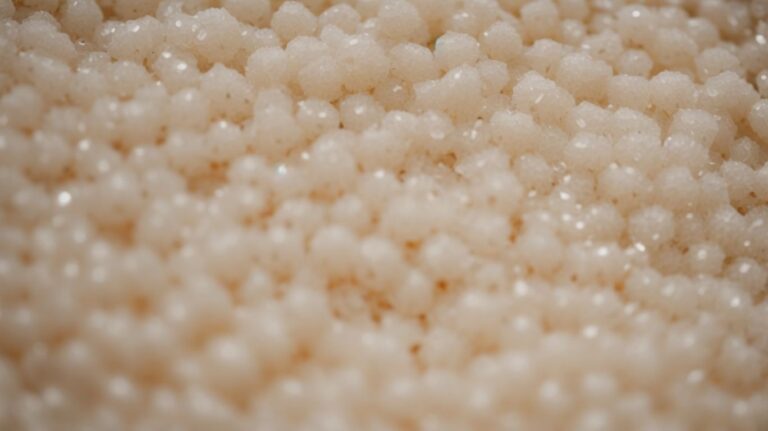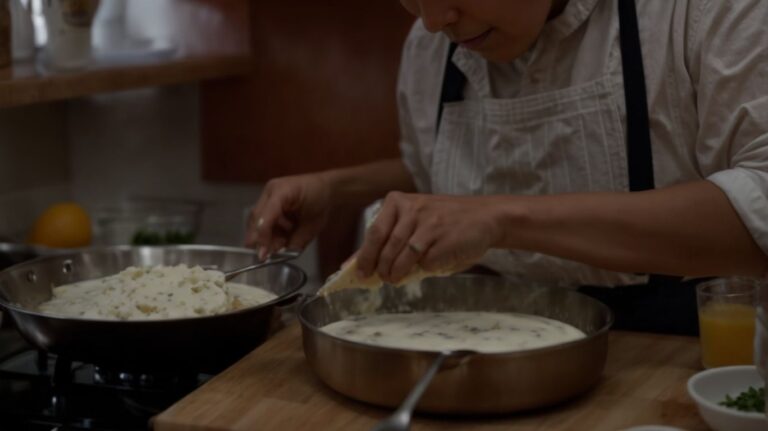How to Cook Noodles for Lo Mein?
Are you craving a delicious and satisfying meal of Lo Mein but not sure where to start? Look no further!
We will guide you through the essential ingredients needed for Lo Mein, including noodles, vegetables, protein, and sauce. We will also provide step-by-step instructions on how to cook the noodles perfectly, along with tips on selecting the best vegetables and protein for your dish.
Stay tuned to learn how to make the perfect Lo Mein at home!
Key Takeaways:
What Are the Ingredients Needed for Lo Mein?
Lo Mein requires a combination of essential ingredients to create a delicious dish.
One of the key components of a flavorful Lo Mein dish is the noodles. Typically, Chinese egg noodles are used, giving a chewy texture and rich flavor to the dish. These noodles are perfect for absorbing the savory sauce, creating a harmonious blend of flavors.
In terms of the sauce, a mixture of soy sauce, oyster sauce, sesame oil, and other seasonings is commonly used to enhance the taste of the dish.
Vegetables play a crucial role in Lo Mein, adding freshness, color, and nutrients. Common vegetables include bell peppers, mushrooms, carrots, and bok choy. They provide a variety of textures and flavors, making each bite exciting.
Protein is another vital ingredient in Lo Mein. Options like chicken, beef, shrimp, or tofu can be added to create a balanced meal. The protein not only adds depth to the dish but also makes it more satisfying and wholesome. The combination of noodles, sauce, vegetables, and protein results in a delightful and fulfilling Lo Mein experience.
Noodles
Noodles play a pivotal role in Lo Mein, offering a satisfying base for the dish.
In terms of choosing the perfect noodles for your Lo Mein,
- Egg noodles stand out as a popular choice. These noodles, made from wheat flour and eggs, bring a rich flavor and a smooth, slightly chewy texture to the dish.
- Another type of noodle that works well with Lo Mein is udon noodles. Udon noodles are thicker and provide a more substantial bite, creating a heartier version of this classic dish.
Both these options can be used either in their uncooked or cooked forms, depending on the desired texture and flavor profile.
Vegetables
A colorful array of vegetables adds freshness and flavor to Lo Mein.
Among the vegetable options commonly used in Lo Mein, bell peppers, garlic, onion, and carrots stand out for their vibrant colors and complementary tastes. Bell peppers bring a crunchy texture and sweetness, while garlic adds a savory depth of flavor. Onions provide a robust taste, and carrots offer a slightly sweet and earthy note. When preparing these veggies for Lo Mein, it’s crucial to julienne or thinly slice them for even cooking and incorporation into the dish.
To incorporate these ingredients seamlessly, stir-fry the bell peppers, garlic, onion, and carrots in a hot wok or pan before adding the noodles and sauce. The high heat ensures a quick cook, retaining the vegetables’ crunch and nutrients. The medley of these colorful veggies not only enhances the visual appeal of the dish but also elevates its overall taste and nutritional value.
Protein (Optional)
Protein choices such as chicken, pork, beef, shrimp, or tofu can elevate the nutritional value of Lo Mein.
When preparing Lo Mein with chicken, opt for thinly sliced pieces marinated in a blend of soy sauce, ginger, and garlic for an added depth of flavor.
Pork, on the other hand, can be stir-fried with a medley of colorful vegetables like bell peppers and snow peas for a sweet-and-savory twist.
Beef presents a rich and hearty option, best when seared to a perfect medium rare before being tossed with Lo Mein noodles and a sesame soy sauce dressing.
Shrimp brings a delicate seafood element to the dish, allowing for a quick sauté in a fragrant mix of garlic, chili, and sesame oil.
For a plant-based alternative, tossing fried or baked tofu cubes in a zesty soy-ginger glaze offers a satisfying and protein-rich option for Lo Mein lovers.
Sauce
The savory sauce in Lo Mein is a harmonious blend of soy sauce, Chinese cooking wine, and other flavorful ingredients.
When creating this signature sauce, chefs meticulously balance the umami-rich soy sauce with the fragrant Chinese cooking wine to enhance the overall depth of flavor. A careful selection of seasonings, such as garlic, ginger, and a hint of sweetness from sugar or honey, is crucial to achieve the perfect combination of savory, sweet, and aromatic notes.
The key lies in simmering the sauce to allow all the ingredients to meld together, creating a rich and velvety texture that coats the noodles and vegetables in the dish. This meticulous process ensures that each component contributes to the final dish’s complexity, resulting in a truly memorable and flavorful Lo Mein experience.
How to Cook Noodles for Lo Mein?

Credits: Poormet.Com – Kyle King
Mastering the art of cooking noodles is crucial for a perfect Lo Mein dish.
When preparing Lo Mein, beginning with the noodles is key. Start by bringing a pot of water to a rolling boil and add a pinch of salt to enhance the flavor. Carefully add the noodles to the boiling water and stir gently to prevent sticking. Follow the package instructions for cooking time but aim for al dente to ensure the noodles retain a slight bite.
Once the noodles are cooked, drain them in a colander and rinse under cold water to stop the cooking process and remove excess starch. This step is vital to prevent the noodles from becoming mushy or clumping together.
Boiling the Noodles
Boiling noodles to the right consistency is the first step towards a successful Lo Mein preparation.
One key aspect to achieving perfectly cooked noodles is to ensure you have a pot of water that is at a rolling boil before adding the noodles. This helps prevent sticking and ensures even cooking. Once you add the noodles, stir gently to separate them and avoid clumping. Timing is crucial here – different types of noodles require different cooking times, typically indicated on the package. Keep a close eye on the noodles as they cook and taste test them towards the end to ensure they are cooked to your preferred texture.
Draining and Rinsing the Noodles
Draining and rinsing noodles post-boiling ensures they are ready for the flavorful stir-frying process in Lo Mein.
Once the noodles are cooked to the desired tenderness, transfer them to a colander placed in the sink. Allow the hot water from the noodles to drain naturally, which helps in washing off the excess starch that can lead to clumping. Gently rinse the noodles under cold running water, handling them carefully to prevent breakage. The cold water rinse not only stops the cooking process but also removes any residual surface starch.
Stir-frying the Noodles
The art of stir-frying noodles in a wok or skillet imparts a delightful aroma and flavor to the Lo Mein dish.
In terms of stir-frying noodles, achieving the perfect texture and taste relies on a few key techniques. Heat control is crucial; make sure your wok or skillet is hot before adding ingredients. Tossing the noodles consistently throughout the cooking process ensures that each strand absorbs the flavors evenly.
The tossing method plays a significant role in preventing sticking and burning. Use a swift, rhythmic motion to keep the ingredients moving and cooking uniformly. This technique not only enhances the flavors but also helps maintain the desired texture of the noodles.
What Vegetables Can Be Used in Lo Mein?
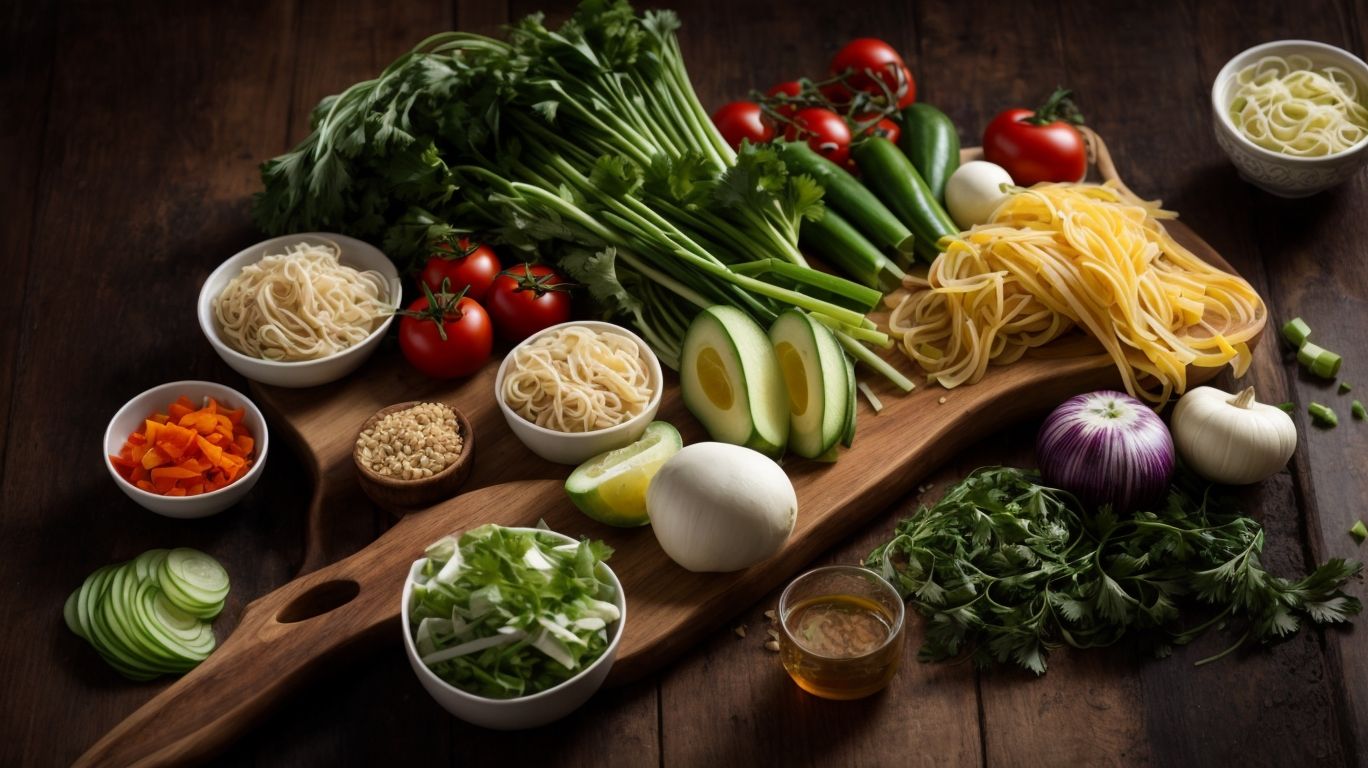
Credits: Poormet.Com – Thomas Young
A variety of vegetables can be incorporated into Lo Mein to add color, texture, and nutritional value.
When preparing a flavorful Lo Mein dish, bok choy can be a great addition. This leafy green vegetable contributes a mild, slightly peppery taste that complements the savory flavors of the dish. To cook bok choy for Lo Mein, it’s best to stir-fry it briefly to retain its crunchiness and vibrant color.
Another excellent vegetable choice is mushrooms, which bring a rich umami flavor and meaty texture to the dish. Sautéing mushrooms before adding them to the noodles enhances their earthy taste.
Additionally, capsicum adds a pop of vibrant color and a sweet, slightly tangy flavor to Lo Mein. Stir-frying capsicum with other ingredients helps maintain its crunch. These vegetables not only enhance the overall taste and appearance of the dish but also provide a variety of nutrients and textures that make each bite satisfying.
Bok Choy
The crisp and leafy bok choy brings a unique crunch and freshness to Lo Mein.
When preparing bok choy for Lo Mein, start by separating the stalks from the leaves. The stalks can be sliced thinly to add a satisfying crunch, while the leaves can be kept whole or roughly chopped for added texture.
For cooking, a quick stir-fry in a hot pan with garlic, ginger, and soy sauce will help retain bok choy’s vibrant green color and maximize its nutritional benefits. Being rich in vitamins A, C, and K, bok choy adds a healthy dose of antioxidants and fiber to your dish.
Bell Peppers
Colorful bell peppers add a vibrant visual appeal and a sweet crunch to Lo Mein.
Bell peppers come in various colors, such as red, yellow, and green, each offering a unique taste experience to the dish. The red peppers are typically the sweetest, adding a subtle sweetness, while the green ones provide a slightly bitter flavor. Yellow bell peppers fall in between, offering a milder taste. This assortment of colors not only elevates the visual presentation of the dish but also introduces a range of flavor profiles.
Mushrooms
Savory mushrooms contribute an earthy richness and umami depth to Lo Mein.
When selecting mushrooms for Lo Mein, opt for varieties like shiitake, cremini, or oyster mushrooms to add a mix of textures and flavors. It is essential to clean them properly by gently wiping with a damp cloth or brushing off any dirt, as mushrooms tend to absorb water quickly. Slicing them thinly or in bite-sized pieces ensures even cooking and allows them to absorb the savory sauce well.
Stir-frying mushrooms at high heat helps to enhance their natural flavors and develop a delicious caramelization, further intensifying the dish’s overall taste.
Carrots
Crunchy carrots bring a subtle sweetness and vibrant color to Lo Mein, enhancing its visual appeal.
When preparing carrots for Lo Mein, start by washing them thoroughly to remove any dirt or impurities. You can then peel the carrots to reveal their bright orange flesh, either using a peeler or a knife for a more rustic look. Next, slice the carrots into thin strips or rounds, depending on your preference, to ensure even cooking and a pleasant texture in the dish.
Carrots not only add a delightful crunch to the Lo Mein but also provide a natural sweetness that balances the savory flavors of the dish. They are packed with essential vitamins and antioxidants, making them a nutritious addition to your meal. The textural contrast they offer, along with their vibrant color, elevates the overall eating experience of this classic Chinese noodle dish.
What Protein Can Be Used in Lo Mein?
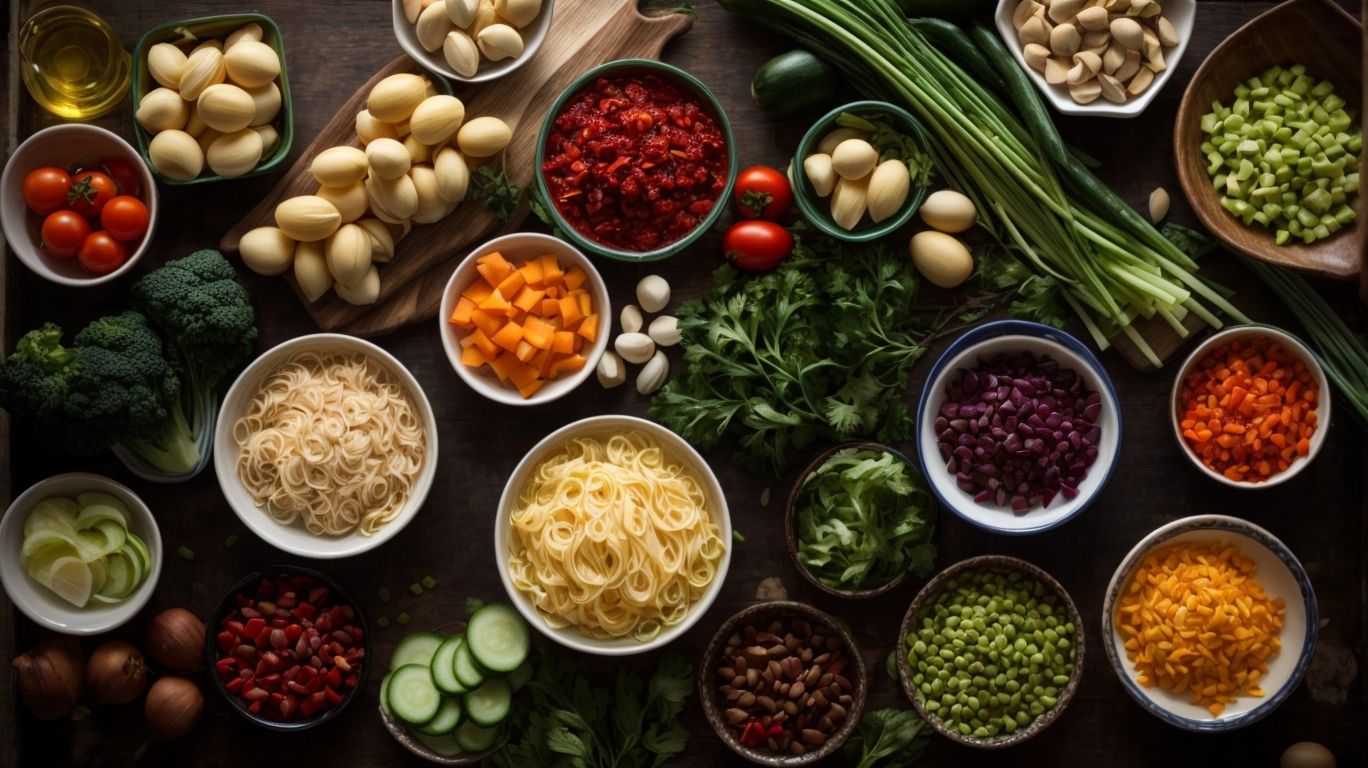
Credits: Poormet.Com – Andrew Wright
Incorporating protein options into Lo Mein adds a satisfying element and nutritional balance to the dish.
In terms of choosing protein for your Lo Mein, there are various delicious options to consider.
- Chicken: Chicken is a classic choice for its tender texture and ability to absorb flavors well.
- Shrimp: Shrimp brings a delightful seafood twist to the dish, infusing it with a fresh and slightly sweet taste.
- Beef: For those who prefer a heartier option, beef can provide a rich and savory element.
- Tofu: On the other hand, tofu is a fantastic plant-based alternative, offering a soft, silky texture with the ability to soak up the flavors of the sauce.
Chicken
Tender and juicy chicken is a popular protein choice that complements the flavors of Lo Mein.
Marinating the chicken before stir-frying in a flavorful mix of soy sauce, garlic, and ginger enhances its tenderness and infuses it with additional layers of taste. When cooking, it’s essential to use high heat and constantly stir to achieve a perfectly seared exterior while keeping the inside juicy and succulent.
The versatility of chicken in Lo Mein allows it to pair seamlessly with various vegetables such as bell peppers, snow peas, and carrots, adding a textural contrast and vibrant colors to the dish. The savory sauce made of soy sauce, oyster sauce, and sesame oil brings out the umami flavors of the chicken and ties all the ingredients together harmoniously.
Beef
Beef offers a rich and hearty protein option for a more robust and flavorful Lo Mein dish.
When preparing beef for Lo Mein, it is crucial to pay attention to the cuts and marination process. Opt for cuts like flank steak or sirloin, and ensure they are thinly sliced against the grain for tenderness. Marinate the beef in a mixture of soy sauce, ginger, garlic, and sesame oil to infuse it with rich flavors.
For cooking, heat a wok or large skillet over high heat and sear the beef slices quickly to create a flavorful crust while keeping the inside tender. Adding vegetables like bell peppers, mushrooms, and bok choy complement the beef beautifully, while the right amount of sauce enhances the dish’s overall taste.
Shrimp
Plump and succulent shrimp bring a delightful seafood element to Lo Mein, infusing a hint of sweetness.
When selecting shrimp for your Lo Mein dish, opt for large or jumbo-size shrimp as they hold up better during cooking and offer a satisfying bite. Deveining the shrimp is key to ensuring a smooth texture and pleasant eating experience, which can be easily done by making a shallow slit along the back and removing the dark vein with a knife or deveiner tool.
Cooking shrimp for Lo Mein should be quick to preserve its tenderness. Briefly sauté the shrimp in a hot wok or skillet until they turn pink and opaque, usually within 2-3 minutes. Overcooking can result in tough and rubbery shrimp.
For flavor pairings, shrimp in Lo Mein pairs beautifully with soy sauce, garlic, ginger, and a touch of sesame oil to enhance its natural sweetness and seafood essence, creating a harmonious balance of flavors in each bite.
Tofu
Tofu offers a versatile and plant-based protein alternative that absorbs the flavors of the sauce in Lo Mein.
In terms of preparing tofu for your Lo Mein dish, there are various methods you can explore. One common method is pressing the tofu to remove excess moisture before cooking, allowing it to absorb flavors more efficiently. Marinating the tofu in a flavorful sauce or seasoning blend can enhance its taste profile and add depth to the final dish. Whether you opt for pan-frying, baking, or stir-frying the tofu, each cooking technique lends a unique texture to the tofu, adding a delightful contrast to the soft noodles in the Lo Mein.
How to Make the Lo Mein Sauce?
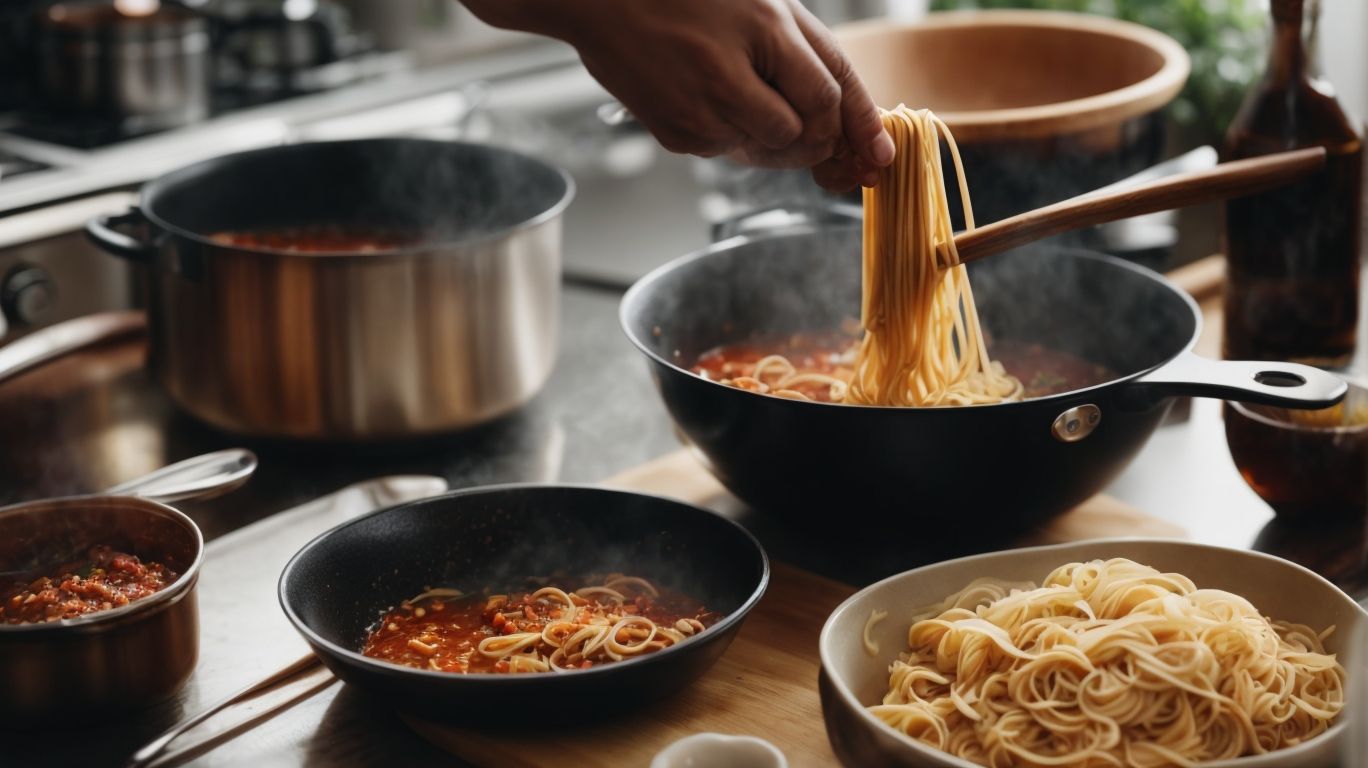
Credits: Poormet.Com – Albert Nelson
The secret to a flavorful Lo Mein lies in the artful creation of the signature sauce.
To craft this delectable sauce, start by combining soy sauce, minced garlic, and freshly grated ginger in a bowl. These fundamental ingredients form the base of the sauce and infuse it with rich umami flavors.
- Next, add a splash of sesame oil for depth and a hint of nuttiness.
- Then enhance the sauce with a touch of sweetness from hoisin sauce and a drizzle of rice vinegar for a perfect balance of flavors.
- For an extra kick, include a pinch of red pepper flakes or a dollop of chili paste to spice things up.
Remember to stir well to ensure all the components blend harmoniously.
Soy Sauce
Soy sauce serves as the cornerstone of the Lo Mein sauce, imparting a deep umami richness and savory depth to the dish.
There are various types of soy sauce available, from light to dark varieties, each offering distinct flavor profiles.
Light soy sauce, with its saltier taste, is commonly used for seasoning and enhancing the natural flavors of the ingredients.
On the other hand, dark soy sauce has a more robust flavor and is ideal for adding color and depth to dishes.
When incorporating soy sauce into the Lo Mein sauce, it’s essential to balance the flavor intensities by adjusting the amounts according to personal preference.
Oyster Sauce
Oyster sauce adds a unique umami complexity and subtle sweetness to the Lo Mein sauce, elevating its flavor profile.
Derived from oysters, this savory condiment boasts a rich, deep flavor that intensifies the overall taste of the dish. Its thick consistency and dark color contribute to the appealing glossy finish of the Lo Mein noodles. Oyster sauce not only enhances the umami notes but also brings a delicate balance of sweetness, making each bite flavorful and satisfying.
Sesame Oil
A drizzle of aromatic sesame oil imparts a distinct nutty flavor and fragrance to the Lo Mein sauce.
Sesame oil serves as the perfect finishing touch for a dish like Lo Mein, enhancing not only the overall taste but also the olfactory experience. It adds depth and richness with its unique aroma that evokes a sense of warmth and comfort. The nuttiness of sesame oil complements the umami flavors in the sauce, creating a harmonious blend that tantalizes the taste buds.
When used sparingly, sesame oil can elevate the dish without overpowering it, striking a delicate balance that brings out the natural flavors of the ingredients. Its versatility allows for a nuanced enhancement, making it a staple in Asian cuisine. Whether drizzled at the end of cooking or used as a marinade, sesame oil has the power to transform a simple Lo Mein into a gourmet delight.
Garlic and Ginger
The aromatic combination of garlic and ginger infuses the Lo Mein sauce with layers of flavor and fragrant complexity.
When preparing the sauce, finely mincing garlic and ginger or grating them can help release their essential oils and flavors, intensifying the taste profile. These aromatic ingredients not only add depth but also provide a subtle heat and pungency to balance the dish’s overall flavors.
To extract the full essence, gently sauté the garlic and ginger in oil over low heat until they turn golden brown, amplifying their aroma before combining the other sauce ingredients. This method ensures that the unique flavors of garlic and ginger permeate through the entire dish, enhancing every bite.
What Are Some Tips for Making the Perfect Lo Mein?
Achieving the perfect Lo Mein requires attention to detail and certain key tips to elevate the dish.
For high-heat stir-frying, ensure your wok is properly heated before adding the ingredients to achieve that coveted wok hei flavor. In terms of ingredient pairing, balance is key – opt for a mix of crunchy vegetables, tender protein like chicken or tofu, and a variety of noodles for textures. The sauce application should be done judiciously, ensuring each strand of noodle is coated evenly without overwhelming the dish. Garnishing with fresh scallions, sesame seeds, or a dash of soy sauce adds a final touch of flavor and visual appeal.
Use High Heat
Employing high heat during stir-frying ensures that the ingredients achieve a perfect sear and caramelization in Lo Mein.
When the wok reaches smoking point, a **distinct sizzle** can be heard as the ingredients hit the surface, signaling the start of intense flavor development. The high heat promotes the Maillard reaction, a chemical process that imparts a nutty and savory depth to the dish while creating a delightful umami essence.
The quick cooking method in stir-frying allows the vegetables to retain their vibrant colors, crisp texture, and nutritional value, making it a healthier option compared to other cooking techniques that may result in overcooking or loss of nutrients.
Cook the Vegetables and Protein Separately
Cooking vegetables and protein separately allows for individual flavor development and optimal texture in the Lo Mein dish.
When vegetables and protein are cooked together, they can release moisture at different rates, resulting in overcooked or undercooked ingredients. By cooking them separately, you have more control over the timing, ensuring that each component is perfectly cooked before combining them.
- Cooking them individually enables you to season each element according to their specific needs, enhancing the overall taste of the dish.
- For vegetables, a quick stir-fry with garlic, ginger, soy sauce, and a dash of sesame oil can elevate their flavors, while proteins like chicken, beef, or tofu can be marinated beforehand for maximum taste impact.
- This method also helps in preserving the integrity of the ingredients, allowing the vegetables to retain their crispness and the proteins to stay tender and juicy.
Add the Sauce at the End
Incorporating the sauce towards the end of cooking ensures that it coats the ingredients evenly and retains its full flavor in Lo Mein.
This technique is crucial as adding the sauce too early can result in it being absorbed too quickly, leading to a loss of its distinct taste. By waiting until the final stages, the sauce is able to meld with the dish, enhancing every bite with its rich flavors.
This method also helps in maintaining the desired consistency of the sauce. When added early, the sauce may thicken too much or become diluted, affecting the overall texture of the Lo Mein.
Don’t Overcook the Noodles
Maintaining a firm and al dente texture in the noodles by avoiding overcooking is key to a successful Lo Mein dish.
Proper noodle cooking times play a crucial role in achieving that perfect balance between chewiness and tenderness. When noodles are overcooked, they tend to become mushy and lose their desirable texture. To ensure your noodles are cooked to perfection, it’s essential to follow the recommended cooking instructions on the package.
A great way to test for doneness is by tasting a strand of noodle a minute or two before the suggested cooking time is up. Noodles should be tender yet slightly firm to the bite. Remember, they will continue to cook briefly after being drained, so timing is crucial.
Frequently Asked Questions
How to Cook Noodles for Lo Mein?
Lo mein is a popular Chinese dish that features stir-fried noodles, vegetables, and protein. If you’ve ever tried making lo mein at home, you may have struggled with getting the noodles just right. Here are some frequently asked questions about how to cook noodles for lo mein.
1. What type of noodles should I use for lo mein?
Traditionally, lo mein is made with wheat-based Chinese egg noodles. These noodles can be found in most Asian grocery stores and are typically labeled as “lo mein” or “egg noodles.” If you can’t find them, you can also use spaghetti or linguine as a substitute.
2. Do I need to cook the noodles before stir-frying?
Yes, it’s important to cook the noodles before stir-frying. This ensures that they are fully cooked and will not become mushy when added to the stir-fry. It also helps to prevent the noodles from sticking together.
3. How do I cook the noodles for lo mein?
To cook the noodles for lo mein, bring a pot of water to a boil and add the noodles. Cook for the recommended time on the package, typically around 3-4 minutes. Drain the noodles and rinse with cold water to stop the cooking process. Toss with a little bit of oil to prevent them from sticking.
4. Can I use fresh noodles instead of dried noodles?
Yes, you can use fresh noodles for lo mein. Just keep in mind that they may cook faster than dried noodles, so adjust your cooking time accordingly. If using fresh noodles, you can skip the step of rinsing them with cold water.
5. How do I prevent the noodles from becoming mushy?
To prevent the noodles from becoming mushy, be sure not to overcook them. Follow the recommended cooking time on the package and make sure to rinse them with cold water after cooking. Also, be sure to add the noodles to the stir-fry at the end, so they don’t sit in the heat for too long.
6. Should I use oil when cooking the noodles?
Yes, it’s a good idea to add a little bit of oil to the noodles when cooking them. This helps to prevent them from sticking together and also adds flavor. You can use any type of cooking oil, such as vegetable or sesame oil.

